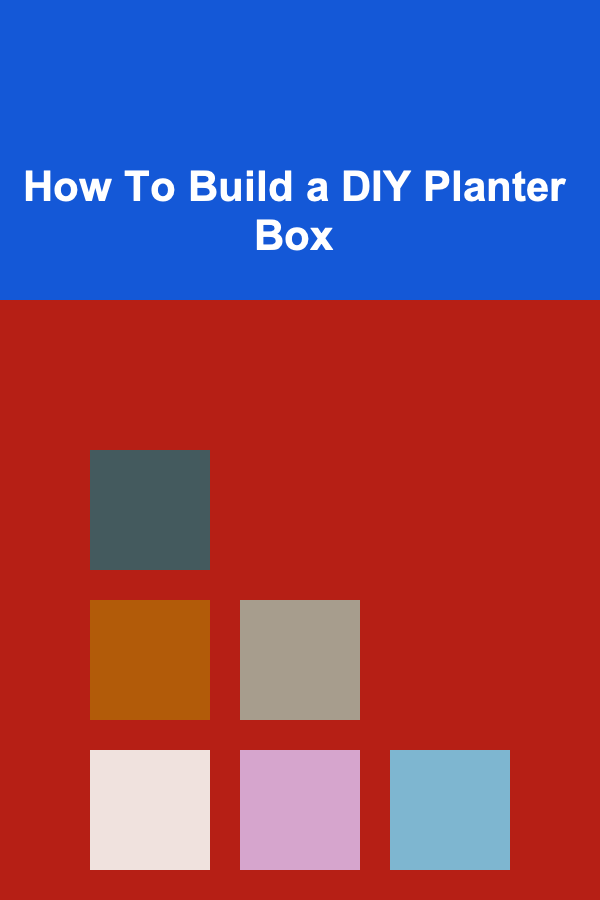
How To Build a DIY Planter Box
ebook include PDF & Audio bundle (Micro Guide)
$12.99$5.99
Limited Time Offer! Order within the next:

Gardening is an activity that brings immense joy to many people. Whether you're a seasoned gardener or just starting, having the right tools and setup is essential. One of the best ways to enhance your gardening experience is by building your own DIY planter box. Planter boxes allow you to grow your favorite plants, herbs, or flowers in a controlled environment. They're also a fantastic way to maximize space, especially for those with limited outdoor areas like balconies, patios, or small backyards.
Building a DIY planter box is a rewarding project that you can complete in a few hours. Not only will you end up with a functional and stylish gardening solution, but you'll also gain a sense of accomplishment from constructing something with your own hands.
This guide will walk you through the step-by-step process of building a basic DIY planter box. We will cover everything from choosing the right materials to assembling your planter and tips for caring for it once it's ready for planting.
Materials and Tools You'll Need
Before you begin, it's essential to gather all the materials and tools required for the job. The materials you use will depend on your preferences, the size of your planter, and the type of plants you plan to grow. For a simple yet durable planter, here is a list of materials and tools you'll need.
Materials
- Wooden Boards: Choose a type of wood that is durable and resistant to the elements. Cedar, redwood, or pressure-treated lumber are good options for outdoor planters. The size of the boards will depend on the dimensions of your planter.
- Screws: Use exterior-grade screws that won't rust when exposed to moisture.
- Wooden Stakes (Optional): For additional support at the corners or the bottom of the planter.
- Landscape Fabric: This helps with drainage and prevents soil from spilling out of the bottom.
- Wood Sealer: For added protection against the elements.
- Drill: For making holes for screws.
- Saw: To cut the wooden boards to the desired dimensions.
- Measuring Tape: For accurate measurements.
- Screwdriver or Impact Driver: To drive the screws into the wood.
- Sandpaper or Sanding Block: To smooth out rough edges on the wood.
- Staple Gun (Optional): For securing landscape fabric to the sides of the box.
Tools for Optional Customization
- Paint or Stain: To customize the look of your planter.
- Paintbrushes or Rollers: For applying the finish to the wood.
Once you've gathered all the materials and tools, you're ready to get started!
Step-by-Step Instructions for Building a DIY Planter Box
Step 1: Plan Your Design
Before diving into cutting the wood and assembling the planter, take some time to plan out your design. Consider the following:
- Size: How large or small do you want your planter box to be? A standard size is typically 24 inches long, 12 inches wide, and 12 inches deep, but you can adjust this to fit your space and needs.
- Style: Do you want a simple rectangular box or something more decorative with extra features like legs or compartments?
- Location: Where will you place your planter box? Consider the climate, exposure to sunlight, and the types of plants you intend to grow.
Sketching out your design can help guide you through the process and ensure everything fits together properly.
Step 2: Measure and Cut the Wood
Once you have your design in mind, it's time to cut the wood. Use the measuring tape to mark the dimensions on each board. Here's how you can break it down:
- Side Panels: For a standard rectangular planter box, cut four panels -- two for the long sides and two for the short sides. The long sides should be the length of your desired planter, and the short sides should be the width.
- Bottom Panel: Cut a panel that matches the dimensions of the bottom of the planter. It will sit between the four sides.
- Optional Corner Supports: If you're using wooden stakes for added stability, cut four pieces to the desired height of the planter.
Step 3: Sand the Edges
After cutting the wood, smooth out any rough edges with sandpaper or a sanding block. This step will make the box look more polished and prevent any splinters from forming when you handle the planter.
Step 4: Assemble the Planter Box
Start by assembling the four side panels. Here's a simple guide to putting everything together:
- Attach the Long Sides to the Short Sides: Begin by aligning the edges of the long side boards with the short side boards. Drill pilot holes through the long side into the short side to prevent the wood from splitting. Secure them with screws.
- Attach the Bottom Panel: Once the four sides are secured, lay the bottom panel in place. If you're using corner stakes for extra support, attach them to the corners and secure the bottom panel to the stakes. Drill pilot holes and use screws to hold the bottom in place.
Step 5: Add Drainage Holes
Good drainage is crucial to prevent water from pooling inside your planter and drowning the roots of your plants. Use a drill to make several holes in the bottom of the box. This will allow water to drain freely from the soil. You can add a layer of gravel to the bottom of the planter as well for better drainage.
Step 6: Install Landscape Fabric
To keep the soil from spilling through the drainage holes, install landscape fabric inside the box. Cut a piece of fabric large enough to cover the sides and bottom of the box. Secure it in place with a staple gun, making sure it covers the entire interior.
Step 7: Seal the Wood (Optional)
If you're using untreated wood, it's a good idea to seal the wood with a wood sealer or stain. This will help protect it from moisture and extend the life of your planter box. Apply the sealer according to the manufacturer's instructions and let it dry completely before moving to the next step.
Step 8: Add Soil and Plants
Once the planter is fully assembled and dry, it's time to fill it with soil. Choose a good quality potting soil suitable for the plants you want to grow. Make sure to leave some space at the top of the box to prevent soil from spilling over when watered. Then, plant your favorite flowers, herbs, or vegetables and water them thoroughly.
Step 9: Maintain Your Planter Box
Proper maintenance will help your planter box last for many years. Here are a few tips for keeping your planter in good shape:
- Watering: Be sure to water your plants regularly, but avoid overwatering. Check the moisture level of the soil before watering again.
- Weeding: Keep an eye out for weeds that may grow in the soil. Remove them promptly to keep your plants healthy.
- Replanting: If you plan to grow different plants each season, you can refresh the soil and replant as needed.
- Sealing and Touch-Ups: If you notice any cracks or damage to the wood, reseal the planter or apply a fresh coat of paint to protect it from the elements.
Conclusion
Building your own DIY planter box is an enjoyable project that results in a practical and beautiful addition to your garden or outdoor space. With just a few materials and some basic tools, you can create a custom planter that fits your exact needs. Plus, it's a great way to showcase your gardening skills and improve your space.
Whether you decide to build a simple rectangular box or a more intricate design, the process is straightforward and rewarding. Once you've completed your planter, you can enjoy growing your favorite plants, whether they're flowers, herbs, or vegetables. And, with proper care and maintenance, your planter will provide you with years of enjoyment.
Now that you've learned how to build a DIY planter box, it's time to roll up your sleeves, grab your tools, and start your project. Happy gardening!

How to Choose the Right Retirement Accounts for Your Future
Read More
How to Make Over Your Bathroom with Inexpensive Upgrades
Read More
How to Use Tackle Boxes for Essential Oil Organization
Read More
Mastering Technical Support: A Comprehensive Guide for Engineers
Read More
How to Navigate the Bustling Hubs of London
Read More
How to Interpret EV Charging Station Maps: A Comprehensive Guide
Read MoreOther Products

How to Choose the Right Retirement Accounts for Your Future
Read More
How to Make Over Your Bathroom with Inexpensive Upgrades
Read More
How to Use Tackle Boxes for Essential Oil Organization
Read More
Mastering Technical Support: A Comprehensive Guide for Engineers
Read More
How to Navigate the Bustling Hubs of London
Read More